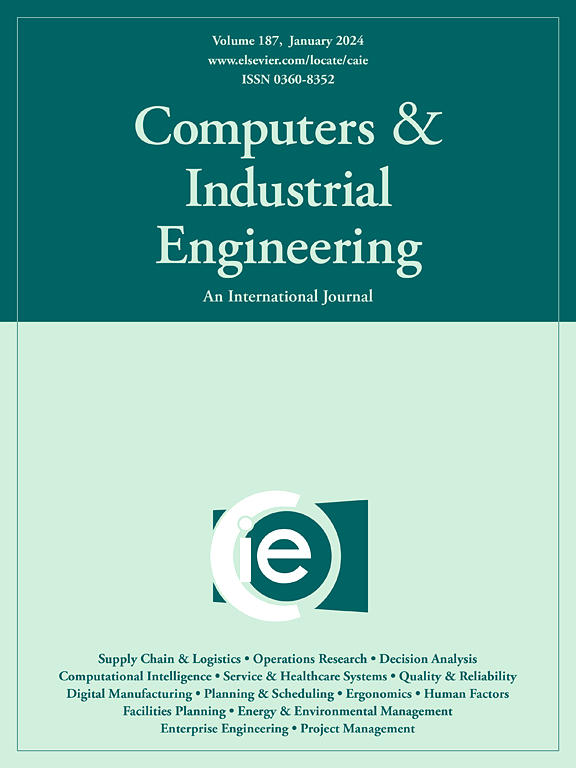考虑混合合同、公共捐赠和物品易腐性,设计弹性人道主义救济链的双目标两阶段随机优化
IF 6.7
1区 工程技术
Q1 COMPUTER SCIENCE, INTERDISCIPLINARY APPLICATIONS
引用次数: 0
摘要
本文提出了一种双目标、两阶段随机规划(TSSP)模型,用于设计弹性人道主义救援链(HRC)。该模型在整合危机前和危机后阶段的决策时,考虑了需求、公共捐赠和中断风险方面的不确定性。该模型优化了关键决策,如供应商选择、建立合同、预先定位物品、库存管理以及易腐和非易腐物品的分配。它的目标是最小化总网络成本和到每个需求点的最大平均旅行时间。为了解决网络设施和链路中断的问题,采用了几种弹性策略,包括库存预定位和持有安全库存,以及备用供应商。此外,还制定了一项混合供应合同,包括政府救济组织与主要和备用供应商之间的数量灵活性合同和选择合同,以确保救济网络的反应能力达到可接受的水平。在GAMS软件中利用epsilon-constraint方法给出了不同的数值实例,并以伊朗大不里士市为例,说明了该方法的适用性。研究结果表明,弹性策略显著提高了成本效率和响应时间,其中最具影响力的策略是预先定位,前者提高了28.42%的总成本,后者提高了84.79%的响应时间。结果回顾和敏感性分析为设计功能有效的HRC提供了有价值的管理见解。本文章由计算机程序翻译,如有差异,请以英文原文为准。
A bi-objective two-stage stochastic optimization for designing a resilient humanitarian relief chain considering hybrid contracts, public donations, and item perishability
This paper presents a bi-objective, two-stage stochastic programming (TSSP) model for designing a resilient humanitarian relief chain (HRC). The model considers uncertainties in demand, public donations, and disruption risks while integrating decisions in both the pre- and post-crisis stages. This model optimizes critical decisions such as supplier selection, establishing contracts, pre-positioning items, inventory management, and distribution of perishable and non-perishable items. It aims to minimize the total network costs and the maximum average travel time to each demand point. To tackle disruptions in network facilities and links, several resilience strategies were adopted, including inventory pre-positioning and holding safety stock, as well as backup suppliers. Additionally, a hybrid supply contract was established, consisting of quantity flexibility contracts (QFCs) and option contracts (OPCs) between the governmental relief organization (GRO) and the main and backup suppliers, ensuring an acceptable level of responsiveness in the relief network. The epsilon-constraint method is utilized in GAMS software to illustrate different numerical instances and a case study of Tabriz City in Iran, demonstrating its applicability. The findings reveal that resilience strategies significantly enhance cost efficiency and response times, with pre-positioning improving overall costs by 28.42% and response times by 84.79% as the most influential strategy. The results review and sensitivity analysis provided valuable managerial insights for designing a functional and effective HRC.
求助全文
通过发布文献求助,成功后即可免费获取论文全文。
去求助
来源期刊

Computers & Industrial Engineering
工程技术-工程:工业
CiteScore
12.70
自引率
12.70%
发文量
794
审稿时长
10.6 months
期刊介绍:
Computers & Industrial Engineering (CAIE) is dedicated to researchers, educators, and practitioners in industrial engineering and related fields. Pioneering the integration of computers in research, education, and practice, industrial engineering has evolved to make computers and electronic communication integral to its domain. CAIE publishes original contributions focusing on the development of novel computerized methodologies to address industrial engineering problems. It also highlights the applications of these methodologies to issues within the broader industrial engineering and associated communities. The journal actively encourages submissions that push the boundaries of fundamental theories and concepts in industrial engineering techniques.
 求助内容:
求助内容: 应助结果提醒方式:
应助结果提醒方式:


